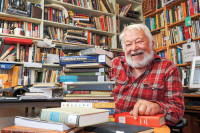HCC construction technology students support the Waynesville Housing Authority
Haywood Community College Construction Technology students recently helped the Waynesville Housing Authority add much-needed storage behind several homes in the Ninevah housing community.
Haywood waterways hosts tree identification hike
On May 18, Haywood Waterways Association and Haywood Community College will lead a moderate 6-mile hike in the Sunburst area of Haywood County.
Carolina Heritage Weekend
A multi-day event celebrating Appalachian heritage, Carolina Heritage Weekend will take place April 18-20 around Haywood County.
WNC Environmental Summit comes to HCC
Join the WNC Environmental Summit March 23 at Haywood Community College.
Paul Allen from “Feed Me Foam” will showcase his mobile densifier technology. Witness firsthand how clean packing foam can be recycled efficiently and sustainably.
The event will begin with a live demonstration at 2 p.m.
Bring your clean packing foam (no food-grade foam, please) and contribute to a greener future. There will also be free recycling information available.
One year later, Canton displays remarkable progress
The woods are lovely, dark and deep,
But I have promises to keep,
And miles to go before I sleep,
And miles to go before I sleep.
— Robert Frost, “Stopping by Woods on a Snowy Evening”
HCC Foundation Professional Crafts fundraiser
The Haywood Community College Foundation inaugural “Evening of Art” event to support the needs of HCC’s Professional Crafts program will be held from 6-9 p.m. Thursday, March 14, in the Sycamore building located on the main campus of HCC in Clyde.
Legal Action sought for injuries in Haywood explosive fire safety drill
Conrad & Scherer, a litigation firm with its headquarters in Fort Lauderdale, Florida, has filed a lawsuit against Fireblast Global, Inc., James R. Nelson, and Steve Sposato, on behalf of Demetrius Massey, who suffered serious injuries due to a massive explosion during a fire safety training exercise.
HCC hosts hunter safety classes
Haywood Community College’s Department of Arts, Sciences, and Natural Resources and the North Carolina Wildlife Resources Commission will offer a variety of hunter safety courses this fall.
Forestry student awarded for academic excellence
Brandon Light, a student in Haywood Community College’s Forest Management Technology Program, has been named the college’s Academic Excellence Award winner.
COVID-19 cluster found following law enforcement class
The Haywood County Health and Human Services Agency has identified a COVID-19 cluster among Haywood County Detention Center staff. The cluster of cases was connected to a detention officer certification training event, held at Haywood Community College from Oct. 5 - Nov. 12.





